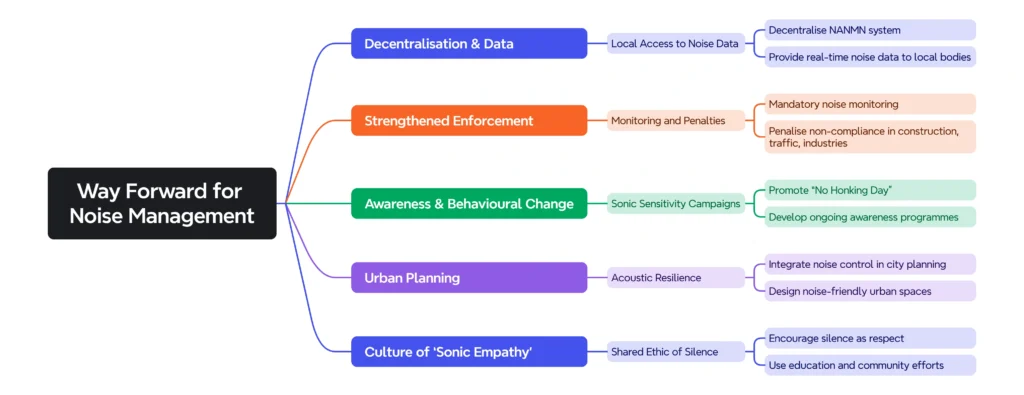Paper: GS – III, Subject: Environment, Ecology and Disaster Management, Topic: Pollution, Issue: Ineffectiveness in tackling noise pollution.
Context:
Urban noise pollution has emerged as a neglected public health crisis.Cities often exceed permissible decibel (dB) levels, violating constitutional promises of peace and dignity.
Key Highlights:
Institutional Framework:
National Ambient Noise Monitoring Network (NANMN): Launched in 2011 by CPCB as a real-time data platform, it now functions largely as a passive repository rather than an enforcement tool.
- However, data is fragmented and inaccessible while accountability is absent.
CPCB Guidelines Issue:
- Noise monitors are often placed at 25–30 feet high, violating norms.
- Incomplete/bias-prone data sets are an issue.
- Contrast with Europe: Europe actively uses mortality/illness data to shape policies.
Noise Pollution Rules, 2000: Outdated, fragmented, lack coordination between authorities.
Constitutional & Legal Dimensions:
- Article 21: Right to life and dignity includes freedom from noise pollution.
- Article 48A: Directive principle mandating protection of environment.
- Supreme Court 2024 ruling: Unchecked noise is a serious threat to mental well-being and civic freedom.
Worsening Factors:

| Case study: University of Auckland (2025 Study):Urban noise + artificial light disrupts sleep and song patterns of birds.Reduced complexity in bird calls → weakens ecological communication.Reflects deeper erosion of urban biodiversity. |
Social & Political Dimensions:
Civic Fatigue and Politics of Silence:
- Normalisation of sonic aggression (honking, drilling, loudspeakers).
- Noise becomes an “ambient irritant” tolerated, not challenged.
- Unlike smoke/waste, noise is invisible → harder to mobilise public outrage.
Policy Gaps:
- Lack of inter-agency coordination.
- No regular updates to Noise Pollution Rules.
- Weak penalties and compliance for violators.
- Overemphasis on symbolic enforcement instead of systemic reform.
Way Forward for Noise Management:

Conclusion:
Urban noise pollution is not just an environmental issue but a constitutional, social, and ecological crisis. Tackling it requires data-driven governance, inter-agency coordination, strict enforcement, and cultural change towards sonic empathy.
La Excellence IAS Academy, the best IAS coaching in Hyderabad, known for delivering quality content and conceptual clarity for UPSC 2025 preparation.
FOLLOW US ON:
◉ YouTube : https://www.youtube.com/@CivilsPrepTeam
◉ Facebook: https://www.facebook.com/LaExcellenceIAS
◉ Instagram: https://www.instagram.com/laexcellenceiasacademy/
GET IN TOUCH:
Contact us at info@laex.in, https://laex.in/contact-us/
or Call us @ +91 9052 29 2929, +91 9052 99 2929, +91 9154 24 2140
OUR BRANCHES:
Head Office: H No: 1-10-225A, Beside AEVA Fertility Center, Ashok Nagar Extension, VV Giri Nagar, Ashok Nagar, Hyderabad, 500020
Madhapur: Flat no: 301, survey no 58-60, Guttala begumpet Madhapur metro pillar: 1524, Rangareddy Hyderabad, Telangana 500081
Bangalore: Plot No: 99, 2nd floor, 80 Feet Road, Beside Poorvika Mobiles, Chandra Layout, Attiguppe, Near Vijaya Nagara, Bengaluru, 560040
